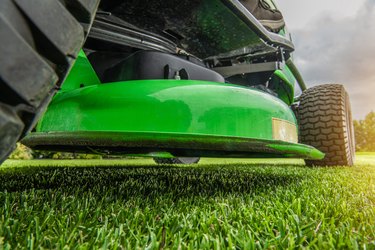
Riding lawn mowers are great for managing larger properties, but the maintenance for them can get expensive and time-consuming. Knowing how to repair small issues, like Craftsman riding mower carburetor problems, can save you a tremendous amount of time, expense and stress.
Craftsman Lawn Tractor Carburetor Repairs
Video of the Day
A clogged or dirty carburetor is often the cause of a riding mower being difficult to start or outright failing to do so. The carburetor manages the flow of fuel and air to the engine, so when it gets clogged or damaged, the entire engine operation suffers.
Video of the Day
Luckily, the process of removing and either cleaning or replacing the carburetor is both simple and affordable. A new Craftsman lawn tractor carburetor is commonly available from a parts warehouse. For about $60 plus shipping and the 20 to 30 minutes it takes to deal with the old carburetor, you can have your riding mower up and running again.
The Craftsman DYS 4500's carburetor may require a licensed repair technician. However, it is also possible for skilled machinists to fix their own at home. You can remove, clean and reinstall the carburetor using a socket wrench, screwdriver and needle-nose pliers. This process should take no longer than 20 minutes.
Repair Best Practices

Anytime you're working on an engine, you'll want to do it on a level surface to avoid the vehicle or parts rolling away, and any liquids will settle directly down instead of running into a lower corner.
Keeping a set of rags nearby to wipe parts clean and a set of low, wide cups to hold screws and other small parts will also help you avoid losing parts and will provide containers to soak particularly dirty or rusted components. Keep WD-40 on hand to strip away grease and loosen stuck bolts. Machine oil or silicone grease will coat and preserve parts as you reassemble them.
Replacing a Craftsman Riding Mower Carburetor
First, disconnect the spark plug to avoid any chance of accidentally starting the engine. Ensure the fuel tank is empty, siphoning any remaining fuel into a glass or other temporary container (do not reuse plastic for any other use after using it for this purpose). Do not return the siphoned fuel to any gasoline canister, as it may be diluted with water.
Next, lift the gas tank upward and use needle-nose pliers to disconnect the gas hose. You can use clamping pliers to pinch off the fuel line so that any amount of gasoline won't be wasted nor spilled.
Remove the air filter by turning it counterclockwise. Evaluate the filter and clean or replace it as necessary. Remove the fuel bowl of the carburetor by loosening the screw with your socket wrench. Carefully pull the bowl down, revealing the carburetor's fuel float. Strip and clean the bowl while ensuring the float is clean and moves freely.
Next Steps in the Repair Process
Carefully use a screwdriver to remove the primer bulb, being sure not to damage the bulb, and remove the air intake valve. Remove the carburetor entirely, being careful not to damage the mounting bolts or the throttle rod or spring. Take your time to remove and disconnect each piece from the carburetor, taking pictures as necessary to remind yourself where the attachments go. Once you've completely removed the old carburetor, you can either clean it and reinstall it or replace the damaged or worn carburetor entirely.

To reinstall the carburetor, you will mostly be reversing the process of removing it. Carefully secure the mounting studs and nuts, securing the throttle rod and spring in place as well as the choke rod. Be sure to look out for the fuel solenoid, removing it prior to deconstruction and cleaning and connecting as you reinstall the carburetor. Ensure that all hoses and nuts are secured tightly with no leaks before attempting to reconnect the spark plug.
Once reassembled, give your machine a test run. Start it and make sure it moves well without odd noises or lurching before storing it or using the tractor for anything heavy duty.